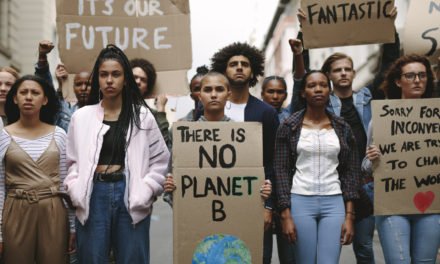
According to U.S. K-12 curriculum standards, I learned about Black history in school. I learned about slavery and emancipation, minstrel shows, Jim Crow laws, the Civil Rights Movement and those boundary-pushing heroes who represented “firsts” in accomplishments among Black folks in the U.S. I learned about the assassination of Dr. Martin Luther King – framed as a tragedy but also as an example of the hatred of the past that had since been “fixed.” During Black History Month, I was tasked with doing a report on a famous Black individual. I dutifully created a poster about Jackie Robinson, then moved onto struggling through long division.
In this vague account of Black history that came together over the course of my primary and secondary school studies was struggle, pain and resistance. What this picture largely lacked was humanization. Empathy for Black people and communities. Any significant exploration of how pervasive anti-Black racism informs cultural understandings and biases. Transparency about the extent to which the U.S. government and white communities in the U.S. were involved in intentional acts of racist terror and violence, historically and to this day.
In this vague account of Black history that came together over the course of my primary and secondary school studies was struggle, pain, and resistance. What this picture largely lacked was humanization. Click To TweetI would argue that, despite studying heroic Black figures, I did not learn about Black excellence — but rather about a romanticized notion of Black resilience in the face of systemic racism. I learned about Blackness if and only if it was acceptable, meaning centering white comfort. It was never made explicit to me (beyond the obvious callout that it was Black History Month and this was important) why it is important to learn about notable Black figures from history.
Despite studying heroic Black figures, I did not learn about Black excellence—rather about a romanticized notion of Black resilience in the face of systemic racism. I learned about Blackness if and only if it was acceptable,… Click To TweetUltimately, my education about the history of Blackness in America was overwhelmingly presented through a deficit-based lens, with little attention to the systems that created the inequities. When I think about the broader cultural impact of this woefully inadequate education, I am unsurprised by the staggering lack of progress on racial justice in the U.S. and abroad.
As I gained more exposure, experience and education across differences in college and beyond, I finally began to understand realities I had never learned about before, as a white student in predominantly white schools, taught by predominantly white teachers, reading textbooks written by predominantly white educators. A sampling of these realities includes:
- Some level of (inherently incomplete) emotional understanding of the lived experience of being captured and enslaved — on a day-to-day basis, for one’s entire life, with no respite
- U.S.-government-sanctioned abuse of Black people through medical experimentation
- U.S.-government-sanctioned harassment of Civil Rights Leaders and subsequent coverups
- The fact that police forces in the U.S. developed from “slave patrols” — volunteer forces of white men tasked with hunting down runaway enslaved people
- The ways that white women have, throughout history, weaponized their whiteness to falsely accuse Black men of harassment or violence (which often led to violence against these men) in order to maintain the status quo
Each of these revelations drastically shifted the story I had learned throughout my prior schooling. Each has informed my subsequent understanding of systemic racism and its modern-day manifestations.
During this time, I also developed an understanding of the vital importance of representation, and of seeking out and consuming creative work from individuals and communities who have been historically marginalized. In the literature, film, music and art I had never been challenged to engage with in primary and secondary school, I encountered not only new perspectives that added to my understanding of the world, but also so much emotion, humanity and joy that had been absent from the texts and media I had engaged with previously. It is unacceptable that even coming from a “progressive” environment, it took me nearly two decades of life to begin unlearning the story of racism which I had been taught all along — and only then because I happened to enroll in courses that highlighted these works.
I now understand how these omissions were an enormous disservice to my own learning and understanding as a white person. I cannot speak personally to how the same omissions impact BIPOC students’ understanding of self and community, but a wealth of research affirms the importance of strengths-based representations for marginalized communities of all kinds. The only beneficiary of these representations being absent from school curriculum is white supremacy.
I now understand how these omissions were an enormous disservice to my own learning and understanding as a white person. The only beneficiary of these representations being absent from school curriculum is white supremacy. Click To TweetThere is a great deal of overdue progress that must be made in the realm of educational policy in the U.S., and diversifying representation and perspectives in school curriculum is only one facet of this broader problem. Still, it is a critical one — and one that faces a great deal of opposition from those committed to upholding white supremacy.
Last month, even as the president’s executive order banning antiracism training in federal government organizations and contractors went into effect, Denver Public Schools passed the “Know Justice, Know Peace” resolution, which outlines a plan for intentionally incorporating BIPOC voices and perspectives in the district’s curriculum. This resolution was spearheaded by learners within the district — women of color who recognized the grave disservice that we are doing our BIPOC and white students alike by leaving so much out of the stories we tell.
I encourage everyone to explore discussions around curriculum that may be happening in your local community. Consider how you can support efforts to diversify representation and perspectives offered in curricula by volunteering, sharing information with others, educating yourself about education-related issues on your ballot, and contacting your representatives, to offer a few ideas. If we are going to see systemic change, we must start by addressing ongoing misunderstandings of race, racism and cultural differences perpetuated by our educational institutions. The earlier we can reach learners with these important truths and pre-empt the need to “unlearn,” the better.
If we are going to see systemic change, we must start by addressing ongoing misunderstandings of race, racism, and cultural differences perpetuated by our educational institutions. Click To Tweet

















